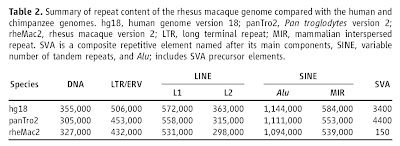So, I have recently become aware that Genomicron is cited on an intelligent design wiki entry for “junk DNA“. They quote two paragraphs from my post A word about “junk DNA”. Specifically, a paragraph in which I critique the term “junk DNA” as unnecessarily implying non-function for all non-coding DNA, and a paragraph in which I list many (unsubstantiated) hypotheses about universal functions for non-coding DNA. Here are two paragraphs from the post that they don’t quote:
To satisfy this expectation, creationist authors (borrowing, of course, from the work of molecular biologists, as they do no such research themselves) simply equivocate the various types of non-coding DNA, and mistakenly suggest that functions discovered for a few examples of some types of non-coding sequences indicate functions for all (see Max 2002 for a cogent rebuttal to these creationist confusions). Case in point: a few years ago, much ado was made of Beaton and Cavalier-Smith’s (1999) titular proclamation, based on a survey of cryptomonad nuclear and nucleomorphic genomes, that “eukaryotic non-coding DNA is functionalâ€. The point was evidently lost that the function proposed by Beaton and Cavalier-Smith (1999) was based entirely on coevolutionary interactions between nucleus size and cell size.
…
Does non-coding DNA have a function? Some of it does, to be sure. Some of it is involved in chromosome structure and cell division (e.g., telomeres, centromeres). Some of it is undoubtedly regulatory in nature. Some of it is involved in alternative splicing (Kondrashov et al. 2003). A fair portion of it in various genomes shows signs of being evolutionarily conserved, which may imply function (Bejerano et al. 2004; Andolfatto 2005; Kondrashov 2005; Woolfe et al. 2005; Halligan and Keightley 2006). On the other hand, the largest fraction is comprised of transposable elements — some of which become co-opted by the host genome, some of which play major role in generating genomic variation, some of which may be involved in cellular stress response, and yet others of which remain detrimental to host fitness (Kidwell and Lisch 2001; Biémont and Vieira 2006). The upshot is that some non-coding DNA is most certainly functional — but when it is, this usually makes sense only in an evolutionary context, particularly through processes like co-option. More broadly, those who would attribute a universal function for non-coding DNA must bear the following in mind: any proposed function for all non-coding DNA must explain why an onion or a grasshopper needs five times more of it than anyone reading this sentence.
Funny that my post Function, non-function, some function: a brief history of junk DNA, in which I discuss how anti-evolutionists are wrong about the history and the science of non-coding DNA, is not quoted.
Here’s a quote they are welcome to use: Simply saying “junk DNA will turn out to have a function” is not a scientifically actionable prediction unless you specify what that function will be and a way to test the proposed function.









Ryan Gregory has serious doubts about the usefulness of the term as he explains in his excellent article A word about “junk DNA”.
Just to clarify, I think the term could be useful — indeed, it was useful when Ohno coined it. The problem is that it is seldom used in an appropriate way. If the meaning were specified explicitly to be “regions strongly suspected of being non-functional with evidence to back it up” (which, incidentally, is not the original definition according to Ohno (1972) or Comings (1972)), and if people used it only in this way, then I would not have a problem with this. But given the difficulty that people seem to have in accepting that some DNA may truly not have a function at the organism level, I don’t know if we could ever get it to be used with such precision.
…a new term, Junctional DNA, to describe DNA that probably has a function but that function isn’t known… think we don’t need to go there. It’s sufficient to remind people that lots of DNA outside of genes has a function and these functions have been known for decades.
That neologism was suggested in response to Minkel’s appeal for a term that would “make the distinction between functional and nonfunctional noncoding DNA clear to a popular audience”. My main suggestion was to call DNA by what it is known to be, if at all possible, by function (“regulatory DNA”, “structural DNA”) or by type (“pseudogene”, “transposable element”, “intron”). Your definition of “junk DNA” is also more precise than most usages, meaning that you specify that the term only be applied to sequences for which there is evidence (not just assumption) of non-function. That leaves us with something in between for journalists to talk about with a catchy buzzword. “Junctional DNA” lets them specify that we’re not talking about “junk DNA” or “functional DNA” — i.e., there is some evidence for function (e.g., being conserved) but no evidence of what that function is. The main utility would be to stop the very frustrating leap that gets made from “this 1% of the genome may have a function, so the whole thing must have this function” kind of reporting. Now they could say “another 1% has moved into the category of ‘junctional DNA'”. I think that would be considerably less misleading than current wording.
Note that I’m avoiding the term “noncoding” DNA here. This is because to me the term “coding DNA” only refers to the coding region of a gene that encodes a protein … there are many genes for RNAs that are not properly called coding regions so they would fall into the noncoding DNA category … introns in eukaryotic genomes would be “noncoding DNA” as far as I’m concerned. I think that Ryan Gregory and others use the term “noncoding DNA” to refer to all DNA that’s not part of a gene instead of all DNA that’s not part of the coding region of a protein encoding gene. I’m not certain of this.
By definition, non-coding DNA is, and always has been, everything other than exons. The reason this is relevant is that early work in genome biology assumed that there should be a 1 to 1 correspondence between DNA content and protein-coding gene number. This is work that occurred for at least two decades before the discovery of introns, pseudogenes, and other non-coding DNA. Now we have more descriptive names for the categories of DNA that are not the genes, all the genes, and nothing but the genes. I actually don’t know of anyone else who would have a problem calling introns, pseudogenes, and regulatory regions “non-coding DNA”. Certainly, Ohno, Crick, and many others have historically put introns in the same non-protein-coding grouping as pseudogenes. It’s just a category — you also have more specific subcategories to apply to each of the types of non-coding DNA. Perhaps your objection relates to an undue emphasis on the distinction between exons and everything else — well, that’s the history of the past half century of this field, so it should be no surprise that the terminology reflects this.
Read Gregory’s article for the short concise version of this dispute. What it means is that junk DNA threatens the worldviews of both Dembski and Dawkins!
Not quite. What you’re leaving out of this is the possibility of multiple levels of selection. In the original edition of The Selfish Gene (1976, p.76), Dawkins argued that “the simplest way to explain the surplus DNA is to suppose that it is a parasite, or at best a harmless but useless passenger, hitching a ride in the survival machines created by the other DNA”. Cavalier-Smith (1977) drew a similar conclusion (before he had read Dawkins), and Doolittle and Sapienza (1980) and Orgel and Crick (1980) [yes, that Crick] independently developed the concept of “selfish DNA” a few years later. This is an explicitly multi-level selection approach because it specifies that non-coding DNA can be present due to selection within the genome rather than exclusively on the organism (or gene, in Dawkins’s case) (see, e.g., Gregory 2004, 2005). (Incidentally, this idea of parasitic DNA dates back at least to 1945, when Gunnar Östergren characterized B chromosomes in this fashion). Of course, they tended to do what Ohno did and applied this one idea to all non-coding DNA, which is too ambitious. The modern view is more pluralistic (see, e.g., Pagel and Johnstone 1992 vs. Gregory 2003). Some non-coding DNA is just accumulated “junk” (in the definition of evidence-supported non-function that you espouse). Some (perhaps most) is “selfish” or “parasitic” and persists because there is selection within the genome as well as on organisms (in fact, an argument could be, and has been, made that “selfish DNA” would be a much more accurate term than “junk DNA” for most non-coding DNA). Some non-coding DNA is clearly functional at the organism level, including regulatory regions and chromosome structure components. Some of these latter functional non-coding DNA sequences are derived from elements that originally were of one of the first two types, most notably transposable elements that take on a regulatory function through co-option (or, in another manner of thinking, that undergo a shift in level of selection).
Junk DNA is not noncoding DNA and anyone who claims otherwise just doesn’t know what they’re talking about.
I’m afraid I don’t follow what you mean here. By your definition, “junk DNA” is any non-functional sequence of DNA, including pseudogenes (i.e., the original meaning). Those sequences do not encode proteins. Hence, your version of junk DNA is non-coding. I think this reflects the confusion that is imposed by the term “junk DNA”, which is why I generally think it is more obfuscating than enlightening.
________
References
Cavalier-Smith, T. 1977. Visualising jumping genes. Nature 270: 10-12.
Comings, D.E. 1972. The structure and function of chromatin. Advances in Human Genetics 3: 237-431.
Dawkins, R. 1976. The Selfish Gene. Oxford University Press, Oxford.
Doolittle, W.F. and C. Sapienza. 1980. Selfish genes, the phenotype paradigm and genome evolution. Nature 284: 601-603.
Gregory, T.R. 2003. Variation across amphibian species in the size of the nuclear genome supports a pluralistic, hierarchical approach to the C-value enigma. Biological Journal of the Linnean Society 79: 329-339.
Gregory, T.R. 2004. Macroevolution, hierarchy theory, and the C-value enigma. Paleobiology 30: 179-202.
Gregory, T.R. 2005. Macroevolution and the genome. In The Evolution of the Genome (ed. T.R. Gregory), pp. 679-729. Elsevier, San Diego.
Ohno, S. 1972. So much “junk” DNA in our genome. In Evolution of Genetic Systems (ed. H.H. Smith), pp. 366-370. Gordon and Breach, New York.
Orgel, L.E. and F.H.C. Crick. 1980. Selfish DNA: the ultimate parasite. Nature 284: 604-607.
Östergren, G. 1945. Parasitic nature of extra fragment chromosomes. Botaniska Notiser 2: 157-163.
Pagel, M. and R.A. Johnstone. 1992. Variation across species in the size of the nuclear genome supports the junk-DNA explanantion for the C-value paradox. Proceedings of the Royal Society of London, Series B: Biological Sciences 249: 119-124.